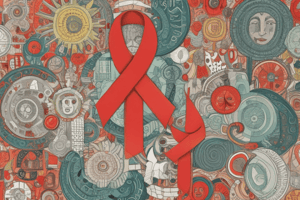Podcast
Questions and Answers
What are the primary modes of transmission for HIV, and how can they be prevented?
What are the primary modes of transmission for HIV, and how can they be prevented?
HIV is primarily transmitted through sexual contact, sharing needles, mother-to-child transmission, and blood transfusions. Prevention methods include using condoms, getting tested regularly, and avoiding sharing needles or engaging in unsafe sex practices.
What are the symptoms of acute HIV infection, and how do they differ from chronic HIV infection?
What are the symptoms of acute HIV infection, and how do they differ from chronic HIV infection?
Acute HIV infection symptoms include flu-like symptoms, rash, and swollen lymph nodes, which last for 1-2 weeks. Chronic HIV infection symptoms may be mild or non-existent, but can include fatigue, weight loss, and diarrhea, as well as opportunistic infections and HIV-associated neurocognitive disorders.
What is the primary goal of antiretroviral therapy (ART), and how does it improve the quality of life for people living with HIV?
What is the primary goal of antiretroviral therapy (ART), and how does it improve the quality of life for people living with HIV?
The primary goal of ART is to suppress HIV replication, reducing the viral load and slowing disease progression. This improves the quality of life and increases life expectancy for people living with HIV.
What is the purpose of post-exposure prophylaxis (PEP), and how does it prevent HIV infection?
What is the purpose of post-exposure prophylaxis (PEP), and how does it prevent HIV infection?
What is the primary goal of pre-exposure prophylaxis (PrEP), and who is it intended for?
What is the primary goal of pre-exposure prophylaxis (PrEP), and who is it intended for?
What are the global HIV statistics, and which regions are most affected by the epidemic?
What are the global HIV statistics, and which regions are most affected by the epidemic?
What is cryosectioning, and what is its typical application?
What is cryosectioning, and what is its typical application?
What is histology, and what is the typical thickness of sections cut using a microtome?
What is histology, and what is the typical thickness of sections cut using a microtome?
What is the role of microtomes in microscopy, and what is the typical thickness of sections cut using a microtome?
What is the role of microtomes in microscopy, and what is the typical thickness of sections cut using a microtome?
What is ultramicrotomy, and what is its typical application?
What is ultramicrotomy, and what is its typical application?
What are the steps involved in preparing a sample for microtomy?
What are the steps involved in preparing a sample for microtomy?
What is the purpose of embedding in sample preparation, and what materials are commonly used?
What is the purpose of embedding in sample preparation, and what materials are commonly used?
Flashcards are hidden until you start studying
Study Notes
Transmission
- HIV is transmitted through:
- Sexual contact with an infected person (vaginal, anal, or oral)
- Sharing needles or syringes contaminated with HIV-infected blood
- Mother-to-child transmission during pregnancy, childbirth, or breastfeeding
- Blood transfusions from an HIV-infected donor (rare in developed countries)
- HIV cannot be transmitted through:
- Casual contact (hugging, kissing, shaking hands)
- Air or water
- Mosquito bites
Symptoms
- Acute HIV infection:
- Flu-like symptoms (fever, fatigue, headache, sore throat)
- Rash, swollen lymph nodes, or muscle and joint pain
- Symptoms may last for 1-2 weeks
- Chronic HIV infection:
- No symptoms or mild symptoms (fatigue, weight loss, diarrhea)
- Opportunistic infections (e.g., pneumonia, tuberculosis)
- HIV-associated neurocognitive disorders (e.g., dementia)
Treatment
- Antiretroviral therapy (ART):
- Combination of medications to suppress HIV replication
- Reduces viral load and slows disease progression
- Improves quality of life and increases life expectancy
- Treatment as prevention (TasP):
- ART reduces the risk of HIV transmission to sexual partners
- Post-exposure prophylaxis (PEP):
- Taking ART within 72 hours of exposure to prevent HIV infection
Prevention
- Safe sex practices:
- Using condoms or other barrier methods
- Getting tested regularly
- Harm reduction strategies:
- Needle exchange programs
- Safe injection practices
- Pre-exposure prophylaxis (PrEP):
- Taking ART daily to prevent HIV infection in high-risk individuals
Epidemiology
- Global HIV statistics:
- Approximately 38 million people living with HIV
- 1.7 million new infections annually
- 690,000 AIDS-related deaths annually
- HIV prevalence:
- Highest in sub-Saharan Africa (24.7% of global cases)
- Increasing in Eastern Europe and Central Asia
- Key affected populations:
- Men who have sex with men (MSM)
- People who inject drugs (PWID)
- Sex workers
- Migrants and refugees
Studying That Suits You
Use AI to generate personalized quizzes and flashcards to suit your learning preferences.




